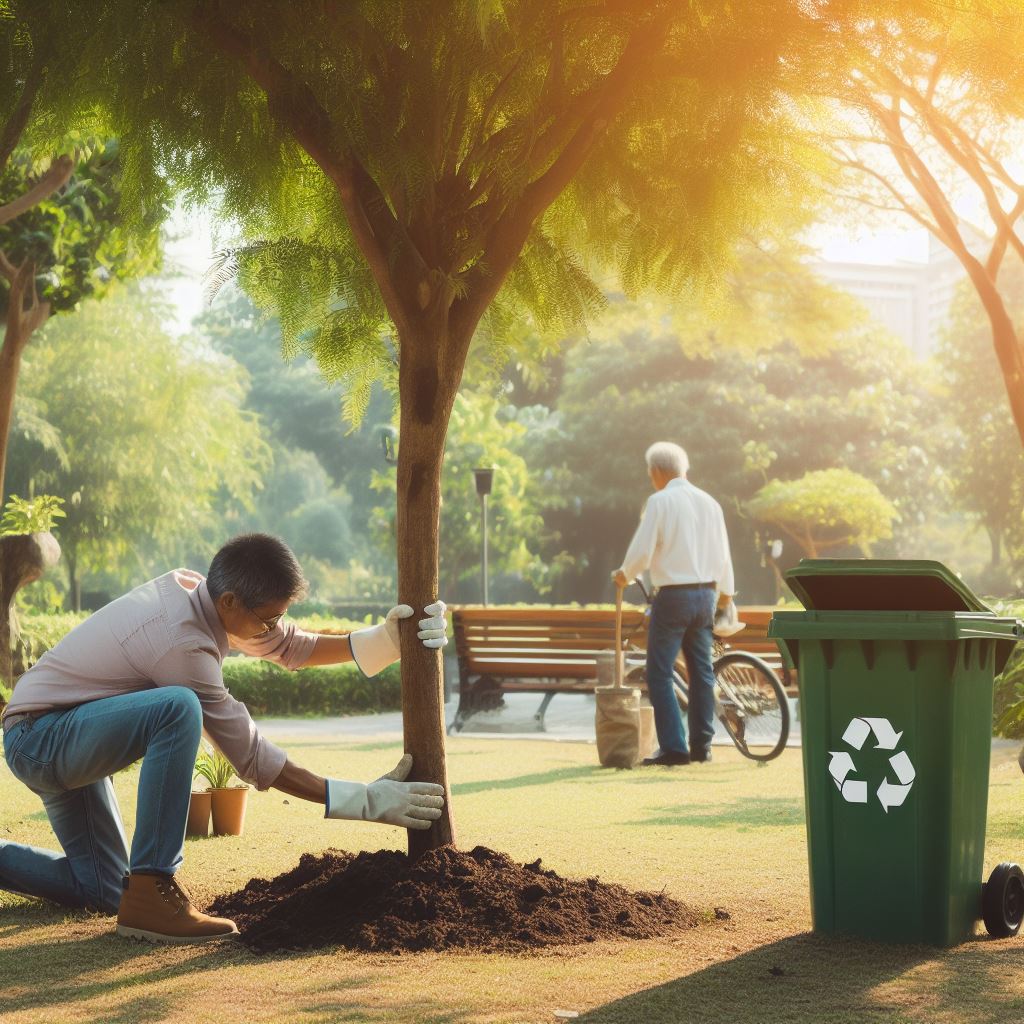Introduction
A. Green Design and Sustainability
Green design, a revolutionary approach, integrates environmental considerations into every stage of a project’s lifecycle.
B. Importance of Sustainability in the US
- Addressing Climate Change: Sustainability aligns with the urgent need to combat climate change, reducing environmental impact.
- Economic Benefits: Embracing sustainable practices fosters innovation, creating jobs and enhancing economic resilience.
- Public Health: A sustainable environment directly contributes to improved public health, reducing pollution and promoting well-being.
- Resource Conservation: Sustainable design prioritizes the efficient use of resources, safeguarding them for future generations.
- Regulatory Compliance: Adhering to sustainable practices ensures compliance with evolving environmental regulations, avoiding legal complications.
In this blog section, we explore how green design and sustainability are crucial elements driving positive change in the United States.
Defining Green Design
Green design refers to the practice of creating environmentally friendly products, buildings, and systems.
Principles and Concepts
- Minimizing Environmental Impact: Designers aim to reduce waste, pollution, and depletion of natural resources in their creations.
- Energy Efficiency: Green design focuses on optimizing energy use, utilizing renewable energy sources, and reducing carbon emissions.
- Sustainable Materials: Designers prioritize using materials that have a minimal impact on the environment, such as recycled or renewable materials.
Examples of Green Design Practices
- Passive Solar Design: Architects strategically design buildings to take advantage of sunlight for heating or cooling purposes.
- Rainwater Harvesting: Systems are set up to collect rainwater for irrigation or other non-potable uses, reducing the demand for freshwater.
- Green Roofs: Vegetative layers are added to rooftops, improving insulation, cooling buildings, and reducing stormwater runoff.
- Biophilic Design: Incorporating nature into the built environment through green spaces, living walls, and natural lighting enhances well-being.
Benefits of Adopting Green Design Principles
- Environmental Conservation: Green design reduces waste, conserves resources, and mitigates the impact on ecosystems and biodiversity.
- Energy Savings: By optimizing energy use, green design reduces energy consumption and lowers utility costs.
- Improved Indoor Air Quality: Using low-toxic materials and proper ventilation systems improves air quality, promoting occupant health.
- Increased Resilience: Green design strategies make buildings and systems more resistant to natural disasters and climate change.
- Economic Advantages: Incorporating green design principles can lead to long-term cost savings, increased property value, and job creation in sustainable industries.
- Health and Well-being Benefits: Access to natural light, green spaces, and cleaner air improves the overall well-being and productivity of occupants.
In essence, green design is a holistic approach that aims to create sustainable and environmentally conscious products, buildings, and systems.
By adopting green design principles, we can minimize our environmental impact, conserve resources, and improve the well-being of both people and the planet.
Read: How to Start Your Interior Design Journey in the USA
The Evolution of Green Design in the US
Green design, also known as sustainable design, is a concept that has gained significant momentum in the US over the past few decades.
It encompasses various practices and approaches aimed at minimizing the negative impact of human activities on the environment.
In this blog section, we will explore the evolution of green design in the US, key milestones and events, as well as the impact of government regulations and policies on this movement.
Historical Overview of the Green Design Movement in the US
In the mid-20th century, awareness about environmental issues started to grow in the US.
Rachel Carson’s book “Silent Spring” published in 1962 triggered widespread concern about pesticide and chemical pollution.
The 1970s saw the birth of the modern environmental movement in the US, with the first Earth Day celebrated in 1970.
During the 1973 oil crisis, energy conservation and sustainability gained attention, leading to the development of green design principles.
The establishment of the US Green Building Council (USGBC) in 1993 promoted sustainable practices in the construction industry.
Key Milestones and Significant Events
- The Energy Policy Act of 1992 laid the foundation for energy-efficient buildings and appliances in the US.
- LEED (Leadership in Energy and Environmental Design) certification system was introduced by USGBC in 2000, setting standards for green buildings.
- In 2005, the USGBC launched the Greenbuild International Conference and Expo, the world’s largest green building conference.
- President George W. Bush signed Executive Order 13423 in 2007, requiring federal agencies to implement sustainable practices.
- The American Recovery and Reinvestment Act of 2009 allocated significant funding for green projects, boosting the green design industry.
Impact of Government Regulations and Policies on Green Design
- Government regulations and policies have played a crucial role in promoting green design practices across the country.
- The introduction of tax incentives and grants encouraged businesses and individuals to adopt sustainable practices.
- Government buildings and public infrastructure projects have been required to meet green building standards, setting an example for the private sector.
- The Department of Energy has implemented appliance efficiency standards, reducing energy consumption and promoting sustainability.
- Government initiatives, such as the Green Power Partnership, have encouraged the use of renewable energy sources.
In short, the green design movement in the US has undergone significant evolution, from its early beginnings in the mid-20th century to the widespread adoption and integration of green practices in various sectors.
Key milestones and events, along with government regulations and policies, have shaped and accelerated the growth of this movement.
As sustainability becomes an increasingly important aspect of our society, green design will continue to play a crucial role in creating a more environmentally friendly future.
Read: Surviving as a Freelance Artist in the American Gig Economy
Current Trends and Innovations in Green Design
In today’s world, there is a growing push for sustainability and eco-friendly practices.
The design industry is no exception to this movement, with an increasing emphasis on green design.
Let’s explore some of the latest trends and innovations in sustainable design:
Latest Trends and Innovations in Sustainable Design
- Biophilic design: Incorporating nature into built environments to improve occupant well-being and productivity.
- Net-zero buildings: Constructing buildings that produce as much energy as they consume.
- Circular design: Emphasizing the use of renewable resources and minimizing waste through recycling and upcycling.
- Smart homes and buildings: Utilizing advanced technology to optimize energy efficiency and reduce environmental impact.
Examples of Eco-Friendly Materials and Technologies
- Bamboo: A rapidly renewable resource that can be used for flooring, furniture, and even textiles.
- Recycled materials: Repurposing materials like glass, plastic, and metals can reduce the demand for new resources.
- Solar panels: Harnessing the power of sunlight to generate clean and renewable energy.
- Green roofs: Installing vegetation on rooftops to reduce heat absorption and stormwater runoff.
- Water-saving fixtures: Implementing low-flow faucets and toilets to conserve water usage.
Integration of Green Design in Various Industries such as Architecture and Fashion
The benefits of green design are being recognized and embraced by industries beyond just architecture.
Here are a few examples:
- Architecture: Architects are incorporating sustainable features like passive design, efficient insulation, and natural ventilation in their projects.
- Fashion: Designers are exploring sustainable fabrics such as organic cotton, hemp, and recycled polyester to create eco-friendly clothing.
- Product design: Manufacturers are focusing on creating products that are made from renewable materials and are easily recyclable or biodegradable.
- Transportation: Automobile companies are investing in electric and hybrid vehicles to reduce emissions and fossil fuel consumption.
Overall, there is a continuous drive towards incorporating green design principles and practices into various industries.
With an increasing awareness of environmental issues, sustainable design is no longer a niche but a necessity for a better and greener future.
Read: Cultural Impact: The Artist‘s Role in American Society
The Role of Businesses in Promoting Sustainability
When it comes to promoting sustainability, businesses have a crucial role to play.
Through their activities and operations, they can significantly contribute to sustainable practices.
Let’s examine how businesses can make a difference and the benefits of implementing green design in commercial settings.
How businesses can contribute to sustainable practices
- Incorporating renewable energy sources: Companies can invest in solar panels, wind turbines, or other renewable energy sources to reduce their reliance on fossil fuels.
- Reducing waste: Implementing waste management strategies such as recycling programs, composting, and waste reduction can minimize the environmental impact of businesses.
- Implementing energy-efficient practices: Adopting energy-efficient lighting systems, equipment, and appliances can help businesses decrease their energy consumption and carbon footprint.
- Encouraging sustainable transportation: Promoting carpooling, using electric vehicles, or providing incentives for public transportation use can help reduce greenhouse gas emissions from employee commuting.
- Supporting sustainable supply chains: Businesses can work with suppliers who prioritize sustainable sourcing, fair trade practices, and ethical labor standards.
Benefits of implementing green design in commercial settings:
- Cost savings: Green design features such as energy-efficient lighting and HVAC systems can significantly reduce operational costs over time.
- Enhanced brand reputation: Adopting sustainability practices can improve a company’s image and attract environmentally conscious consumers.
- Increased employee productivity: A sustainable workplace with better indoor air quality and natural lighting can enhance employee well-being and productivity.
- Compliance with regulations: Green design can help businesses meet regulatory standards and avoid potential fines or penalties.
- Resilience to climate change: Sustainable practices can make businesses more resilient to the impacts of climate change, such as extreme weather events or resource scarcity.
Case studies of companies leading the way in sustainable business practices
Several companies have already taken significant steps in integrating sustainability into their business models.
Let’s look at a few inspiring examples:
- Patagonia:‘This outdoor clothing company is well-known for its commitment to environmental sustainability.
They have implemented green design principles throughout their supply chain, use recycled materials, and prioritize fair trade practices. - Interface:‘This global modular flooring company aims to have no negative environmental impact by 2020.
They focus on reducing waste, using renewable energy sources, and employing closed-loop manufacturing processes. - Unilever:‘Unilever has set out ambitious sustainability goals, including reducing their environmental footprint and enhancing the livelihoods of people across their value chain.
They actively promote sustainable agriculture and responsible sourcing of raw materials. - Tesla: As a leader in electric vehicles, Tesla is revolutionizing transportation while promoting sustainability.
Their electric cars contribute to reduced emissions, and they also invest in renewable energy solutions such as solar panels.
These companies serve as pioneering examples, demonstrating that businesses can thrive while focusing on sustainability and environmental responsibility.
Transform Your Career Today
Unlock a personalized career strategy that drives real results. Get tailored advice and a roadmap designed just for you.
Start NowIn general, businesses have a crucial role to play in promoting sustainability.
By incorporating sustainable practices, they can not only reduce their environmental impact but also enjoy numerous benefits.
With more companies following suit, we can create a greener and more sustainable future.
Read: Art Festivals & Fairs: Showcasing Talent Across the US

Uncover the Details: US Design Awards: Recognizing Excellence in Graphic Arts
Discover More: Educational Pathways for Aspiring Landscape Architects
Challenges and Obstacles in Adopting Green Design
Obstacles and barriers faced by those trying to embrace green design principles
- Resistance from established industries reluctant to change their traditional practices.
- Limited understanding and awareness of the benefits and importance of green design.
- High initial costs associated with implementing sustainable technologies or materials.
- Lack of regulatory frameworks and incentives to encourage businesses and individuals to adopt green design.
- Complexity in assessing the long-term return on investment and financial viability of green design projects.
- Perceived disruptions to existing operations and work processes during the transition to sustainable practices.
- Limited availability and affordability of eco-friendly materials and technologies.
- Challenges in balancing aesthetics and functionality with sustainable design principles.
- Resistance from stakeholders who prioritize short-term economic gains over long-term environmental benefits.
- Uncertainty regarding the actual environmental impact and performance of green design initiatives.
- Resistance from individuals who are resistant to change or have a lack of understanding about green design.
- Complex and lengthy certification processes to meet sustainability standards and regulations.
Socioeconomic factors influencing the adoption of sustainable practices
- Income disparities that limit affordability and access to green products and technologies.
- Limited education and awareness of sustainable practices among certain socioeconomic groups.
- Lack of government support and incentives for economically disadvantaged communities to adopt green design.
- Higher costs of sustainable alternatives compared to conventional products in some cases.
- Reliance on fossil fuel-based industries and technologies for economic growth and development.
- Regional disparities in terms of access to resources and infrastructure for sustainable practices.
- Cultural and societal norms that prioritize convenience and consumption over sustainability.
- Limited economic opportunities and job creation in the green design and renewable energy sectors.
- Inadequate access to financing options and capital for individuals and businesses to invest in sustainable practices.
- Political and policy barriers that hinder the implementation of sustainable practices.
- Lack of collaboration and coordination among different stakeholders in promoting sustainability.
- Resistance from traditional communities or industries that fear the disruption of their way of life.
Strategies to overcome challenges and promote sustainability on a larger scale
- Educational campaigns and awareness programs to inform and educate the public about the benefits of green design.
- Government incentives and subsidies to offset the initial costs of adopting sustainable practices.
- Development of comprehensive and clear regulatory frameworks that support and encourage green design.
- Collaboration between businesses, governments, and NGOs to foster innovation and develop sustainable solutions.
- Investment in research and development to improve the affordability and accessibility of eco-friendly materials and technologies.
- Engagement of communities and stakeholders in the decision-making process to address their concerns and gain support.
- Implementation of green building codes and standards to ensure the integration of sustainable practices in construction.
- Encouragement of sustainable procurement practices and the use of environmentally friendly products.
- Promotion of sustainable lifestyles through conservation and efficient use of resources.
- Incentivizing businesses to adopt sustainable practices through recognition and certification programs.
- Creation of green jobs and training programs to support economic growth and job creation in the sustainable sector.
- Collaboration with international organizations and sharing of best practices to learn from global experiences.
The Benefits of Green Design for Individuals and Society
Advantages of incorporating green design into everyday lives
- Improved air and water quality, reducing the risk of respiratory diseases and waterborne illnesses.
- Energy efficiency leads to cost savings on utility bills, allowing individuals to allocate resources elsewhere.
- Green buildings offer better acoustics, reducing noise pollution and enhancing overall comfort levels.
- Integration of natural light in design enhances mood, productivity, and overall well-being.
- Use of sustainable materials reduces waste, promotes recycling, and minimizes negative environmental impacts.
Positive impacts on health, well-being, and quality of life
- Green spaces promote physical activity, improving cardiovascular health and reducing obesity rates.
- Access to nature and green environments has been proven to reduce stress and increase mental well-being.
- Green design in schools improves learning outcomes, concentration levels, and student performance.
- Implementation of biophilic design elements provides psychological benefits, connecting humans with nature.
- Integration of green roofs and walls in buildings offers aesthetic beauty and urban habitat for biodiversity.
Contributions to mitigating climate change and preserving natural resources
- Reduced carbon emissions through energy-efficient buildings and renewable energy sources.
- Implementation of sustainable transportation systems encourages the use of public transport, walking, and cycling.
- Water conservation strategies, such as rainwater harvesting and greywater recycling, reduce strain on water resources.
- Efficient waste management systems promote recycling and composting, minimizing landfill space and methane emissions.
- Preservation of green spaces and ecosystems improves biodiversity and natural habitats for various species.
In fact, green design not only benefits individuals by improving their health, well-being, and quality of life, but also contributes to mitigating climate change and preserving natural resources for future generations.
By incorporating sustainable practices and utilizing green technologies, we can create a more harmonious and sustainable society.
It is imperative that we embrace green design in our everyday lives to ensure a healthier, more prosperous future.
Learn More: Work Visas for International Animators in the USA
Gain More Insights: Motion Graphics Designer: Education Requirements
Conclusion
A. Recap of the Significance of Green Design and Sustainability in the US
Green design is pivotal, addressing environmental concerns and shaping a sustainable future. Its significance lies in:
- Environmental Preservation: Green design safeguards ecosystems and minimizes the carbon footprint.
- Resource Efficiency: Sustainable practices ensure optimal resource utilization, reducing waste and promoting longevity.
- Human Health: Eco-friendly designs contribute to healthier living spaces, fostering well-being and reducing pollutants.
B. Final Thoughts on the Future of Green Design and Its Potential Impact on Society
The trajectory of green design in the US hints at transformative societal effects.
In closing:
- Innovation: Ongoing advancements will drive creativity, bringing forth new sustainable technologies and methodologies.
- Global Influence: As a leader, the US can inspire worldwide adoption of green design, amplifying its positive impact.
- Community Empowerment: Green initiatives empower communities, fostering a collective responsibility for a sustainable, harmonious future.
[E-Books for Sale]
The Big Book of 500 High-Paying Jobs in America: Unlock Your Earning Potential
$19.99 • 500 High-Paying Jobs • 330 pages
Explore 500 high-paying jobs in America and learn how to boost your career, earn more, and achieve success!
See All 500 High-Paying Jobs of this E-Book
1001 Professions Without a Degree: High-Paying American Jobs You Can Start Now
$19.99 • 1001 Professions Without a Degree • 174 pages
Discover 1001 high-paying jobs without a degree! Unlock career tips, skills, and success strategies for just $19.99!




